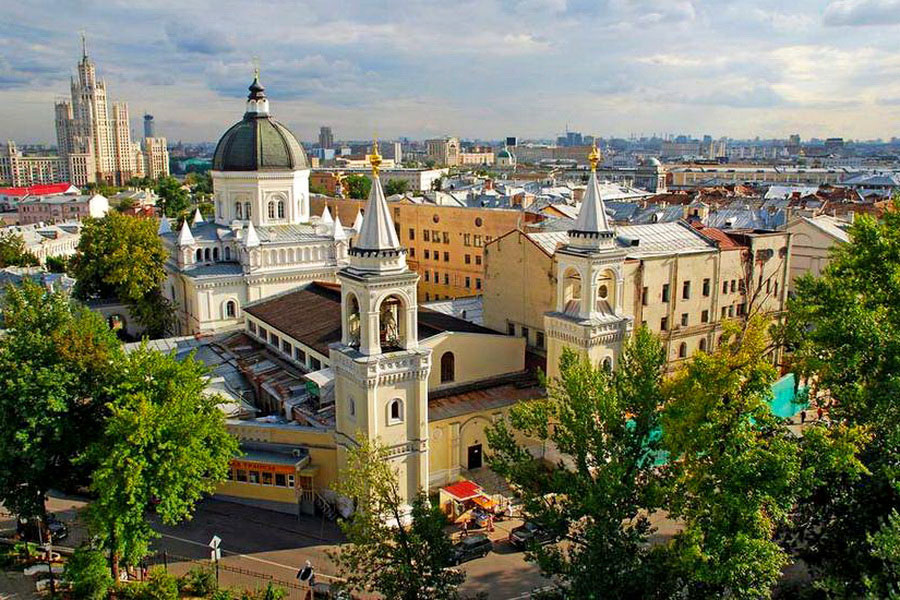
Ivanovsky Convent in Moscow is one of the oldest hermitages in Russia’s capital. Considered the city’s foremost monument to John the Baptist, it successively served as an infamous prison, hospital, concentration camp and Soviet headquarters before regaining its sacred status in modern times.
Ivanovsky Convent is commonly referred to as John the Baptist Nunnery or John the Baptist Convent. Many believe that its inception began at St. John the Baptist Monastery, a men’s cloister located across the Moscow River from the convent.
Around 1530, the convent was established by Prince Vasili III and his wife to celebrate the birth of their son, the future Tsar Ivan the Terrible. Named Ivanovsky Convent, it was built in the Moscow neighborhood of Kulishki and eventually gave rise to the area’s new nickname, Ivanovo Mountain (Ivanovskaya Gorka).
The original abbey was built by an Italian architect in the cross-style fashion typical for churches of that period and topped with a single dome. In the second half of the 16th century it was renovated, presumably at the expense of Tsar Ivan the Terrible himself. In the early 1640s, its cathedral was expanded and a refectory, St. Nicholas the Wonderworker Chapel and a belltower added to the complex. John the Baptist Cathedral, added in 1657, became the first stone building of the monastery. In the early 18th century, by decree of Peter I, all of the convent’s wooden structures were rebuilt with stone.
Moscow’s rulers regularly pilgrimaged to Ivanovo Convent, which also served as the burial grounds for many of the city’s affluent families. In later years, the nuns who served at the convent and those who donated to its reconstruction would also be buried here.
In 1760, when Empress Elizabeth Petrovna ordered care facilities be opened in Moscow for widows, orphans and the destitute, she appointed Ivanovo Convent to be repurposed as such. Although the sudden death of Empress Petrovna brought the project to a halt, the convent was soon converted into a prison for some of the most notorious criminals and outcasts of Russia. Darya Nikolayevna Saltykova, a female serial killer of noble birth, was imprisoned here for decades, and legend holds that in the late 18th century Princess Tarakanova, whose royal origins were hotly disputed, was relocated to Ivanovsky Convent as a nun under the pseudonym Dosifeya. Suspicion that some of Ivanovsky’s nuns were members of the errant Khlysty sect further tainted the convent’s image.
In 1812, the convent-turned-prison for Russian female criminals was looted and burned to the ground during the French invasion of Moscow. In the aftermath of the attacks, Ivanovsky Convent was converted into a parish church. In 1816, funds and icons were donated for the monastery’s refurbishment, yet it was not until 1859 that reconstruction of Ivanovo Convent truly got underway. By 1877 the work was nearly completed, but its reopening was halted when the Russo-Turkish War broke out, and in June of that year the abbey was converted into a makeshift hospital. The consecration of the nunnery finally took place in October 1879, at which time many of the relics seen in the convent today were added. The new complex was designed so that all of the nuns’ activities were confined to two adjoined buildings, and visitors were only permitted to enter the enclosed courtyard.
With the advent of Soviet rule, life at the abbey was again disrupted: bank accounts were liquidated, property confiscated and church valuables seized. Most of its territory was allocated to the Ministry of Internal Affairs (MIA). A section of the compound was even converted into a concentration camp, which during its peak in the 1920s housed hundreds of political prisoners. The nunnery was used as a prison from World War II onwards, while the main hall remained occupied by the MIA as late as the 1980s.
In 1992, Ivanovsky Convent was returned to the Russian Orthodox Church. In 1995, it was reconsecrated after extensive restoration work, and in 2002 many of its holy items were returned, including the icons of St. John the Baptist and Elizabeth The Wonderworker.
Today, guided tours offer visitors a firsthand glimpse of Ivanovsky Convent in Moscow, which once again functions as an active nunnery.

